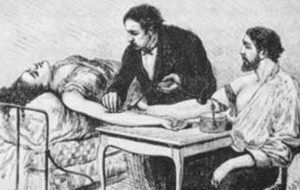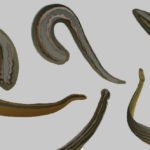 Weird Stuff
Weird Stuff  Weird Stuff
Weird Stuff  Mysteries
Mysteries 10 Tragic Disappearances and Deaths in Joshua Tree National Park
 History
History 10 Ways Childhood Really Sucked in the Old West
 Music
Music 10 Name Origins of Famous Bands from the 1990s
 Religion
Religion 10 Biggest Turnarounds by the Catholic Church
 Weird Stuff
Weird Stuff 10 Unbelievable Times Laws Had Unintended Consequences
 Humans
Humans Ten Historic Women Who Deserve Way More Credit Than They Got
 Movies and TV
Movies and TV 10 Films That Spawned Major Lawsuits
 History
History Ten Times Towns Were Wiped Off the Face of the Earth
 Creepy
Creepy 10 of the Most Disturbingly Haunted Public Houses in the UK
 Weird Stuff
Weird Stuff 10 Niche Subcultures That Are More Popular Than You Might Think
 Mysteries
Mysteries 10 Tragic Disappearances and Deaths in Joshua Tree National Park
 History
History 10 Ways Childhood Really Sucked in the Old West
Who's Behind Listverse?

Jamie Frater
Head Editor
Jamie founded Listverse due to an insatiable desire to share fascinating, obscure, and bizarre facts. He has been a guest speaker on numerous national radio and television stations and is a five time published author.
More About Us Music
Music 10 Name Origins of Famous Bands from the 1990s
 Religion
Religion 10 Biggest Turnarounds by the Catholic Church
 Weird Stuff
Weird Stuff 10 Unbelievable Times Laws Had Unintended Consequences
 Humans
Humans Ten Historic Women Who Deserve Way More Credit Than They Got
 Movies and TV
Movies and TV 10 Films That Spawned Major Lawsuits
 History
History Ten Times Towns Were Wiped Off the Face of the Earth
 Creepy
Creepy 10 of the Most Disturbingly Haunted Public Houses in the UK
Top 10 Debunked Historical Medical Treatments
Throughout history, humanity’s quest for healing and wellness has led to the development of various medical treatments, some of which now seem extraordinary and bizarre. However, as medical knowledge expanded and scientific understanding deepened, many historical medical treatments were exposed as ineffective and dangerous. These top ten treatments serve as a testament to the evolution of medicine and the importance of evidence-based practices in modern healthcare.
Related: 10 Medical Miracles Doctors Still Can’t Explain
10 Milk Transfusions

The history of milk transfusions can be traced back to ancient times when various cultures experimented with unconventional medical treatments. One of the earliest recorded instances dates back to ancient Egypt, where milk was believed to possess mystical healing properties and was used in rituals to treat certain ailments. Similarly, ancient Indian Ayurvedic texts mentioned milk transfusions to rejuvenate the body and cure diseases.
During the 17th and 18th centuries, milk transfusions gained popularity in Europe, primarily as a treatment for tuberculosis and other respiratory illnesses. However, these attempts were largely ineffective and often resulted in adverse reactions due to the lack of understanding of the human immune system and blood compatibility.
As medical science progressed, the theory behind milk transfusions was debunked. Modern scientific research revealed that milk contains different proteins, electrolytes, and other components that can cause severe allergic reactions and even lead to anaphylactic shock when introduced directly into the bloodstream. Consequently, milk transfusions were abandoned as a medical practice and replaced by more effective, evidence-based treatments.
9 Tobacco Smoke Enemas
Tobacco smoke enemas, a historical medical practice, originated in the 18th century as a remedy for various ailments. The technique involved blowing tobacco smoke into a patient’s rectum using a specially designed apparatus. The rationale behind this bizarre practice was that the nicotine and other chemicals in the tobacco smoke would enter the bloodstream through the rectal mucosa and provide therapeutic benefits.
One of the earliest recorded uses of tobacco smoke enemas was by Indigenous American tribes, who utilized the method to treat conditions like headaches, colds, and even drowning victims. Later, European physicians adopted the practice of resuscitating individuals who had drowned. By the 19th century, tobacco smoke enemas had become widely used in Western medicine to treat various ailments, especially near-drowning incidents.
However, as medical knowledge advanced, it became evident that tobacco smoke enemas were ineffective and caused burns and infections. By the 20th century, advancements in modern resuscitation techniques and the discovery of the adverse health effects of tobacco smoking discredited the practice. The use of tobacco smoke enemas was gradually abandoned, and they are no longer considered a legitimate medical treatment.
8 Mercury
Mercury has a long and fascinating history in medical treatments, dating back thousands of years. Ancient civilizations, such as the Egyptians, Greeks, and Chinese, believed in its healing properties. Mercury-based compounds, like mercuric oxide, calomel, and mercury chloride, were prevalent in traditional medicine worldwide. It was believed that mercury could cure various ailments, including syphilis, wounds, and even mental disorders.
During the Renaissance and the early modern period, mercury gained significant popularity in Europe as a treatment for various conditions. Physicians widely prescribed mercury-based ointments, pills, and suppositories. However, as medical knowledge advanced and scientific understanding improved, the true nature of mercury’s effects on the human body became apparent.
Prolonged exposure to even small amounts of mercury can lead to a condition known as mercury poisoning, or mercurialism, which results in symptoms like tremors, cognitive impairment, and other neurological issues. By the late 19th and early 20th centuries, the dangers of mercury were well-documented, leading to a decline in its medical use.
7 Whirling Rotation Therapy
Whirling rotation therapy is a medical treatment that dates back to ancient times. Its origins can be traced to various cultures where spinning was believed to have therapeutic effects on certain medical conditions. One of the earliest documented instances of this practice can be found in ancient Sufi mysticism, where “Sama” or spinning was performed to induce a trance-like state and achieve spiritual enlightenment.
In the 19th and early 20th centuries, whirling rotation therapy gained popularity in the Western world as a treatment for various neurological and psychiatric disorders, including mental illness and hysteria. Physicians and therapists believed that inducing rotational movements could somehow re-balance the inner ear and nervous system, leading to potential healing effects.
However, as medical knowledge advanced and scientific research expanded, the claims of whirling rotation therapy began to be debunked. The practice was found to be potentially harmful, as it could lead to dizziness, nausea, and even accidents. As a result, whirling rotation therapy gradually fell out of favor in mainstream medicine, and today, it is considered a debunked and outdated approach to medical treatment.
6 Radioactive Water
The history of radioactive water in medical treatments traces back to the early 20th century when the discovery of radioactivity revolutionized the field of medicine. Pioneering scientists and physicians like Marie Curie explored the potential of radioactive substances in therapeutic applications. Radioactive water emerged as a possible treatment for various ailments, primarily due to its perceived ability to deliver localized radiation to affected areas, targeting tumors and diseased tissues.
Throughout the 1920s and 1930s, radioactive water gained popularity as a complementary therapy for conditions such as arthritis, cancer, and other chronic diseases. However, as medical understanding advanced, concerns about the potential dangers of radiation exposure grew. The use of radioactive water faced mounting scrutiny, especially with the emergence of more controlled and precise radiation therapy techniques.
By the mid-20th century, the dangers of using radioactive water became evident, with reports of severe side effects and an increased risk of developing radiation-induced illnesses. As a result, the medical community began to abandon this practice, opting for safer and more effective treatments like chemotherapy and targeted radiation therapies.
5 Urotherapy
Urotherapy, also known as urine therapy or auto-urine therapy, is a medical practice that dates back centuries and involves using one’s own urine as a form of treatment for various health conditions. The history of urotherapy can be traced to ancient civilizations such as India, China, and Egypt, where urine was considered a potent remedy due to its perceived therapeutic properties. Advocates believed that urine contained healing elements that could aid in treating wounds, skin conditions, and internal ailments.
In the early 20th century, urotherapy gained popularity in Western medicine, particularly in Europe and the United States. Proponents claimed that urine’s composition included vitamins, hormones, and antibodies that could boost the immune system and facilitate healing. However, as scientific understanding and medical research advanced, the credibility of urotherapy came into question.
Modern medical research has thoroughly debunked the claims of urotherapy’s efficacy. While urine does contain some waste products, it is not a reliable source of essential nutrients or healing agents. In fact, using urine as a medical treatment can be potentially harmful. It may introduce harmful bacteria or toxins back into the body, leading to infections or other adverse effects.
4 Vibrators
The history of vibrators in medical treatments dates back to the 19th century when they were initially invented as non-sexual devices. During this time, doctors used vibrators to treat various medical conditions, including muscle aches, pain, spinal disease, deafness, and male impotence.
However, they were primarily used to treat “hysteria” in women. Hysteria, a vague diagnosis attributed to women experiencing a range of symptoms, was believed to be caused by a “wandering uterus” that needed stimulation to induce “hysterical paroxysm” or what we now understand as an orgasm. Vibrators were considered a suitable medical tool to achieve this outcome.
By the early 20th century, the medical community began questioning the validity and ethics of such treatments. As scientific knowledge advanced, the concept of hysteria as a medical condition was debunked, and the use of vibrators for sexual stimulation in medical settings became controversial due to inappropriate usage.
Eventually, the vibrator entered the private sphere, and its sexual uses became more widely acknowledged. This transformation contributed to the development of the adult industry, where vibrators became a popular consumer product for sexual pleasure.
3 Heroin as a Cough Medicine
Heroin has a rather intriguing and controversial history in the medical field. It was initially developed in the late 19th century by the German pharmaceutical company Bayer, with the trade name “Heroin,” as a potential replacement for morphine—a commonly used painkiller. Bayer marketed heroin as a cough suppressant and a non-addictive alternative to morphine. Its popularity grew quickly, and it was widely prescribed for various medical conditions, including respiratory ailments and coughs.
However, it soon became evident that heroin was far from the safe and non-addictive drug it was claimed to be. Medical professionals began observing its highly addictive nature, leading to widespread abuse and addiction. Over time, it became evident that heroin’s potential for addiction outweighed any medical benefits it might offer. Consequently, the medical community and governments worldwide began to debunk its use in medical treatments.
By the early 20th century, the dangers of heroin were well recognized, and its production and distribution for medical purposes were heavily restricted. Its classification as a Schedule I controlled substance, signifying high potential for abuse and no accepted medical use, further solidified its removal from legitimate medical treatments.
2 Cutting Teeth
Throughout history, cutting teeth has been a prevalent medical treatment used to alleviate the pain and discomfort associated with teething in infants and young children. This practice dates back centuries and was based on the belief that teething caused various illnesses and behavioral issues in children. The procedure involved making incisions or lancing the gums to supposedly facilitate the eruption of teeth and release “bad humors” that were thought to be causing the child’s distress. Often, cutting teeth led to infections and unnecessary pain for the infant or child.
However, as medical knowledge advanced, the understanding of teething and its effects on children evolved. By the late 19th and early 20th centuries, medical professionals began questioning the effectiveness and safety of teeth cutting. Research indicated that the symptoms previously attributed to teething were more likely due to other underlying causes, such as normal developmental changes, infections, or other illnesses.
Debunking the practice of cutting teeth gained momentum as pediatric medicine progressed. Today, the term “cutting teeth” is often used to describe the emergence of teeth through the gums, but it does not involve a medical procedure of cutting or incising the gums. Instead, the process of teething is a natural developmental milestone in infants and children as their teeth break through the gums. Modern medical guidelines now emphasize supportive care measures, such as using teething rings, providing cold objects for chewing, and administering pain-relief medications when necessary to ease the discomfort experienced during teething.
1 Trepanning
Trepanning, also known as trephination or trephining, is an ancient medical practice involving drilling holes into the human skull. This procedure dates back thousands of years and has been found in various cultures worldwide, from ancient Egypt and China to pre-Columbian America.
Initially, trepanning was carried out as a part of spiritual or religious rituals, believing it could release evil spirits, cure illnesses, or alleviate mental disorders. However, over time, it evolved into a medical treatment for various ailments, including head injuries, seizures, and migraines.
As medical knowledge advanced and the understanding of anatomy and physiology improved, trepanning fell out of favor. By the Middle Ages, it had largely been replaced by other medical techniques and was no longer considered a mainstream treatment. The advent of evidence-based medicine and more effective and less invasive medical procedures further contributed to its decline.
In modern times, trepanation is generally referred to as craniotomy and is performed with advanced diagnostic imaging techniques to pinpoint issues within the brain. Craniotomies are used for various neurosurgical procedures, such as the treatment of hematomas or the removal of brain tumors.








